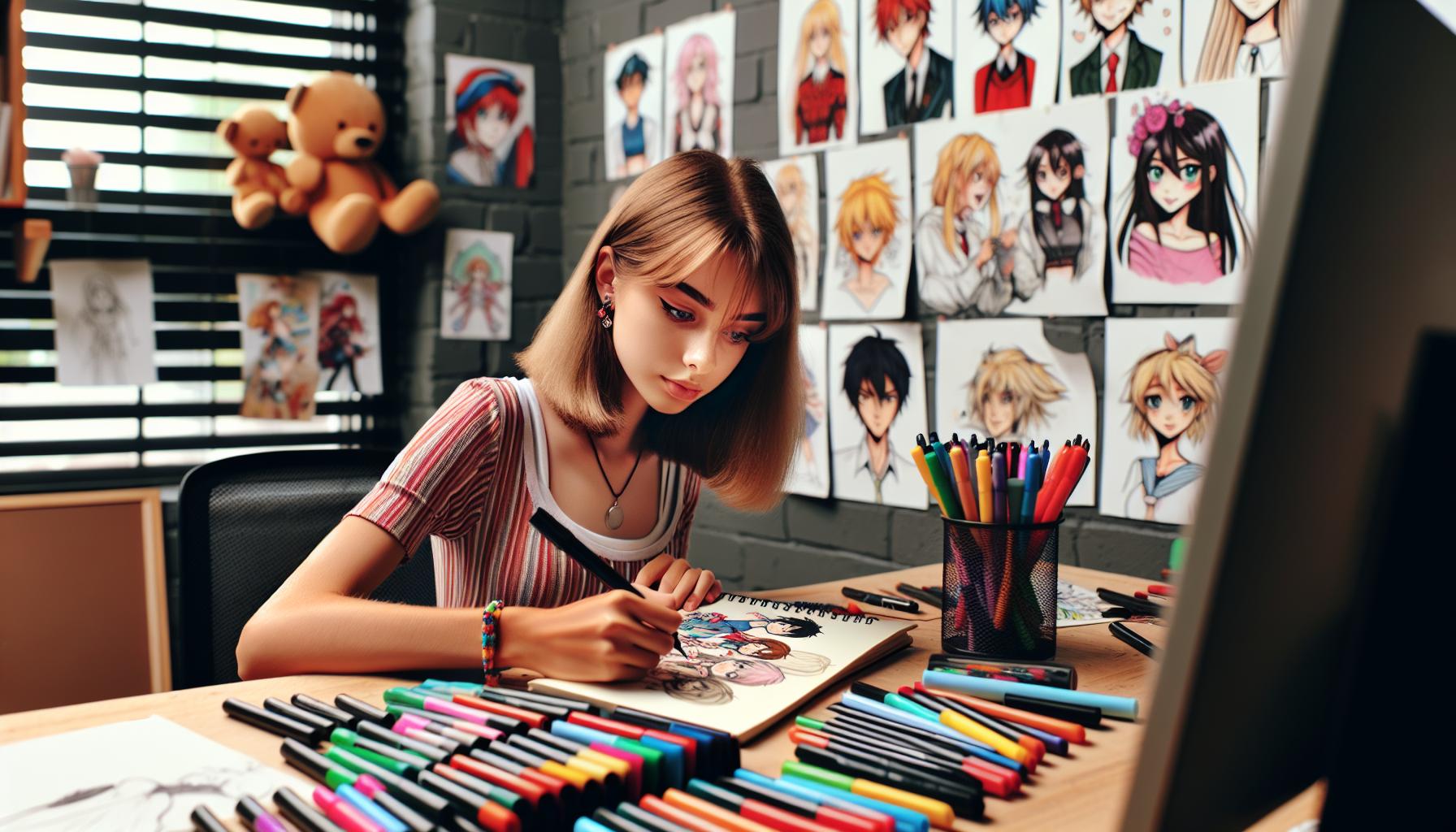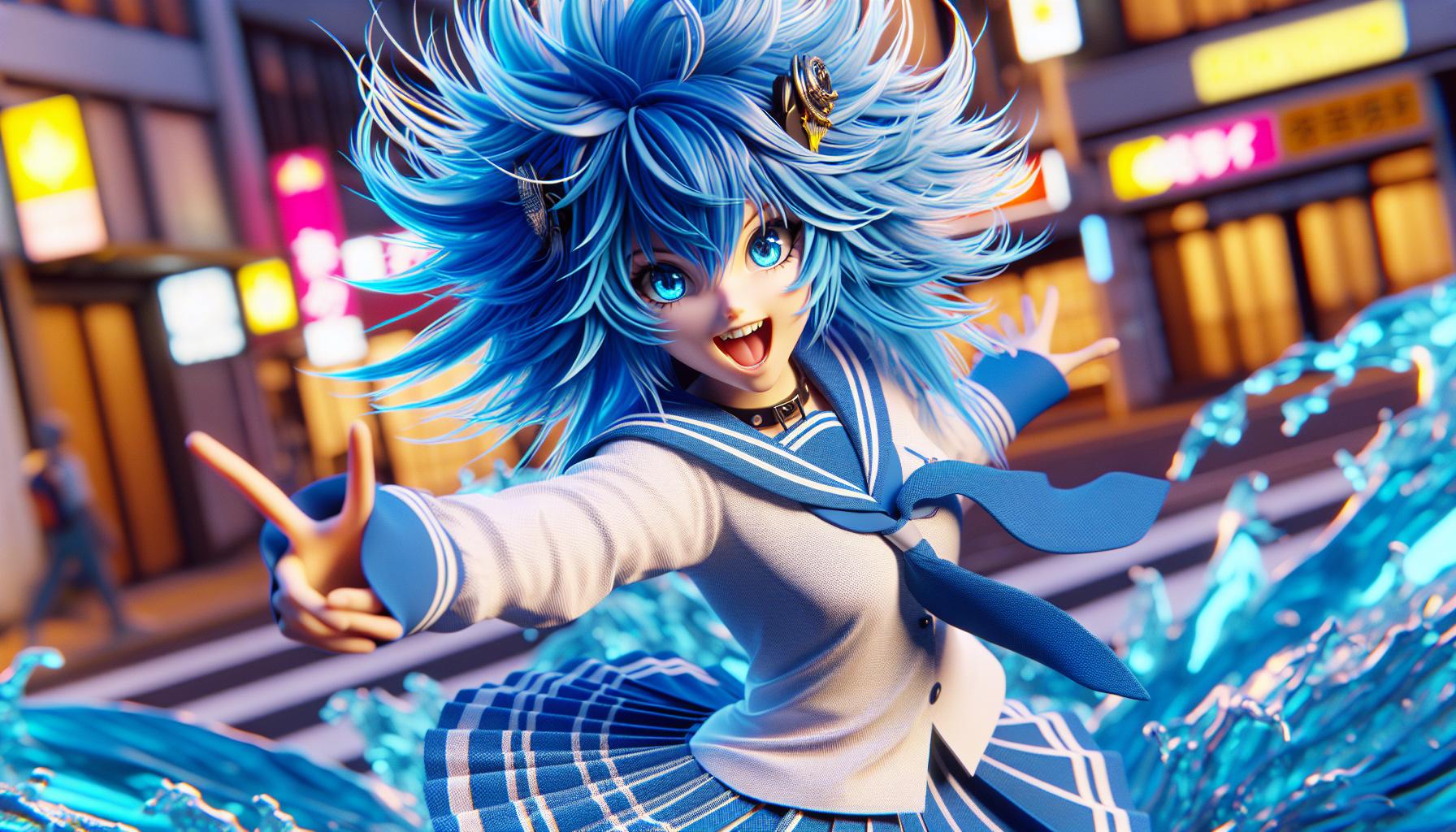Drawing anime characters has become a global phenomenon that captures the hearts of artists and enthusiasts alike. From the expressive eyes to the dynamic hairstyles these beloved Japanese-style illustrations continue to inspire millions of aspiring artists worldwide.
Whether you’re a complete beginner or an experienced illustrator the art of anime drawing offers endless creative possibilities. With its unique blend of simplified features and emotional depth this distinctive style has evolved far beyond its Japanese origins to become a universal artistic language that transcends cultural boundaries.
Anime:qg2kton9p6o= Drawing
Anime art embodies distinctive characteristics that set it apart from other illustration styles. The visual elements combine exaggerated features with simplified forms to create anime:qg2kton9p6o= drawing instantly recognizable characters.
Basic Character Proportions
Anime characters feature specific body proportions that emphasize artistic expression over realism. The standard anime:qg2kton9p6o= drawing stands 7-8 heads tall with elongated limbs creating an elegant silhouette. Female characters typically display slender builds with longer legs while male characters showcase broader shoulders with defined musculature. The torso occupies 2-3 head lengths with arms extending to mid-thigh level. Artists use these proportions as guidelines to maintain consistency across different poses angles. Head shapes follow an oval structure with a pointed chin measuring approximately 1.5 times wider than the neck.
Distinctive Facial Features
Anime faces incorporate large expressive eyes that occupy up to one-third of the face width. The eyes contain multiple highlights reflections irises that convey emotion through size shape positioning. Noses appear minimalist often represented by a single line or subtle shading. Mouths range from small delicate curves to dramatic expressions based on character personality mood. Hair styles feature geometric patterns vibrant colors defying gravity in signature anime fashion. Facial features shift dramatically during emotional scenes with eyes expanding mouths changing shape eyebrows becoming more pronounced.
Essential Drawing Materials and Tools

Creating anime:qg2kton9p6o= drawing requires specific tools tailored to achieve the distinctive style’s clean lines, dynamic shading, and expressive features. The right materials enhance artistic capabilities and streamline the creation process.
Digital vs Traditional Methods
Digital art tools offer extensive customization through software like Clip Studio Paint, Photoshop, and Procreate with features including pressure-sensitive brushes, layers, and unlimited undos. A anime:qg2kton9p6o= drawing tablet connects artists directly to digital canvases, ranging from budget-friendly Wacom One tablets to professional Cintiq displays with built-in screens.
Traditional methods utilize physical materials:
- Paper Types: Bristol board, marker paper, sketch pads (90-120 GSM)
- Drawing Tools:
- Mechanical pencils (0.3mm-0.5mm)
- Fine-liner pens (0.1mm-0.8mm)
- Alcohol-based markers
- Colored pencils
| Tool Type | Digital Cost Range | Traditional Cost Range |
|---|---|---|
| Basic Setup | $200-500 | $50-100 |
| Professional | $1000-2500 | $150-300 |
| Monthly Supplies | $10-30 (Software) | $20-50 (Materials) |
Digital methods excel in production efficiency while traditional approaches offer tactile control. Many artists combine both methods, sketching traditionally then finishing digitally for optimal results.
Mastering Basic Anime Drawing Techniques

Basic anime:qg2kton9p6o= drawing techniques form the foundation for creating expressive characters with distinctive Japanese-style features. These core skills enable artists to develop their unique style while maintaining anime’s characteristic visual elements.
Line Art Fundamentals
Line art serves as the skeleton of anime:qg2kton9p6o= drawing, defining character shapes through precise strokes and confident mark-making. Artists start with light gesture lines to establish dynamic poses before adding defining contours. Clean linework emphasizes key anime features like sharp chin angles, almond-shaped eyes and geometric hair sections. The line weight varies between thick outlines for main shapes and thin lines for interior details such as clothing folds or facial features. Smooth, continuous strokes create flowing hair while angular lines define clothing edges. Professional artists use varying pressure techniques to achieve line tapering effects that add depth to their illustrations.
Shading and Coloring
Anime art employs distinct shading patterns to create depth and dimension in character designs. Cell shading techniques use clearly defined light and shadow areas rather than gradual transitions. Artists place highlights on hair strands, eyes and specific clothing segments to create visual interest. Color palettes typically include 3-4 main tones per element: base color, shadow color and highlight color. Digital artists use layers to separate shading elements while traditional artists blend colors using markers or colored pencils. The eyes receive special attention with multiple highlight spots and color gradients to achieve the signature anime sparkle effect. Strategic placement of shadows under the chin, in hair sections and along clothing folds creates the characteristic anime depth style.
Character Design Elements

Character design in anime:qg2kton9p6o= drawing requires attention to specific visual elements that create memorable personalities. These elements combine to form distinctive characters that resonate with viewers.
Hair and Expression Styles
Anime hair styles feature geometric shapes with dynamic spikes, curves or flowing lines that defy gravity. Characters’ hair colors range from natural tones to vibrant hues like electric blue or hot pink. Short hairstyles use angular cuts with clean edges, while longer styles incorporate sweeping curves and detailed strand patterns. Facial expressions utilize exaggerated eye shapes, including sparkles, gradient shading and detailed reflections to convey emotions. Common expression elements include anger marks, sweat drops and blush lines that emphasize emotional states. Artists incorporate these visual cues to create instantly recognizable character personalities.
Clothing and Accessories
Anime character outfits reflect their roles, personalities and story settings through distinctive design choices. School uniforms feature sailor collars, pleated skirts or traditional gakuran jackets. Combat characters wear detailed armor with geometric patterns, belts and practical gear pouches. Accessories include hair clips, ribbons, glasses and jewelry that add visual interest and personality traits. Clothing incorporates strategic folds, wrinkles and movement lines to create dynamic silhouettes. Fantasy characters display elaborate costumes with flowing fabrics, ornate details and culture-specific elements. The clothing design balances practical function with artistic flair to enhance character appeal.
Adding Dynamic Poses and Movement
Dynamic poses breathe life into anime:qg2kton9p6o= drawing characters through fluid motion and expressive gestures. Creating movement in anime art captures the energy and emotion that defines this distinctive style.
Action Sequences
Action sequences in anime:qg2kton9p6o= drawing emphasize dramatic angles and exaggerated movements. Artists enhance impact through speed lines, motion blur effects and dynamic camera angles. Key poses feature extreme postures with stretched limbs and twisted torsos to convey power and momentum. Overlapping action frames show the progression of movement, from wind-up to follow-through positions. Impact frames freeze the most intense moments using dramatic perspective and radiating effect lines. Artists incorporate environmental elements like dust clouds, sparks or energy auras to amplify the sense of motion and force.
Emotion Through Body Language
Body language communicates character emotions through pose choices and gestural details. Confident characters stand tall with squared shoulders and direct eye contact. Shy personalities curve inward with lowered heads and clasped hands. Anger manifests through clenched fists, wide stances and forward-leaning postures. Joy appears in open arms, lifted chins and bouncing movements. Artists emphasize emotional states by exaggerating natural body positions. Small details like finger positions, foot placement and spine curves reinforce the character’s emotional state. The combination of facial expression and body language creates clear emotional storytelling.
Background and Scene Creation
Scene composition forms the foundation of compelling anime:qg2kton9p6o= drawing. Backgrounds establish mood through perspective lines color schemes atmospheric effects. Professional anime artists integrate architectural elements natural landscapes urban settings to create immersive environments.
Perspective and Composition
Strong perspective techniques create depth in anime:qg2kton9p6o= drawing. One-point perspective works effectively for indoor settings like classroom corridors hallways. Two-point perspective adds dimension to city streets building exteriors. Artists use vanishing points to align structural elements buildings trees vehicles ensuring proper spatial relationships.
Environment Design
Environmental elements enhance storytelling through visual context:
- Urban Settings: Modern cityscapes feature towering skyscrapers neon signage crowded streets
- Natural Landscapes: Rural scenes incorporate rolling hills traditional architecture seasonal elements
- Interior Spaces: Room designs reflect character personalities through furniture decoration lighting
- Fantasy Worlds: Unique environments blend realistic architectural elements with imaginative features
Atmospheric Effects
Atmosphere creates mood through carefully planned visual elements:
- Lighting: Dramatic shadows sunbeams window reflections establish time of day
- Weather: Rain effects fog clouds snow impact scene emotion
- Time: Dawn dusk night scenes utilize specific color palettes shadow placement
- Season: Cherry blossoms autumn leaves summer heat waves winter snow convey temporal setting
Scene Integration
Character placement within backgrounds requires attention to scale proportion environmental interaction. Foreground elements frame scenes direct viewer attention create visual flow. Background details complement character actions without overwhelming focal points.
| Scene Element | Purpose | Common Applications |
|---|---|---|
| Perspective Lines | Depth Creation | Buildings Streets Interiors |
| Color Schemes | Mood Setting | Time Weather Season |
| Environmental Props | Context Building | Furniture Vehicles Signage |
| Atmospheric Effects | Emotion Enhancement | Weather Lighting Time |
Unique Blend Of Artistic Expression
Drawing anime:qg2kton9p6o= drawing offers a unique blend of artistic expression and cultural connection that continues to inspire artists worldwide. The distinctive style with its exaggerated features dynamic poses and detailed scenes provides endless creative possibilities for both beginners and experienced artists.
Whether working digitally or traditionally artists can develop their skills by mastering fundamental techniques while adding their personal flair to this beloved art form. The combination of technical precision emotional storytelling and creative freedom makes anime drawing a rewarding artistic journey that resonates across cultures and skill levels.
The future of anime:qg2kton9p6o= drawing remains bright as new generations of artists embrace this versatile medium bringing fresh perspectives to this timeless style.



